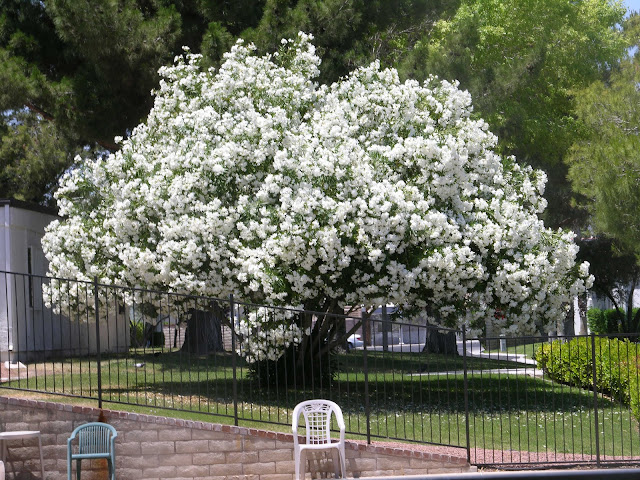Q.
I have a large old 40-foot oleander tree. Every year as it begins to flower, some
of the leaves turn yellow and drop. I realize I may need to fertilize but I was
also thinking of cutting the trunks at about 20 feet, just below where it
branches to encourage new healthier growth. Do you think this is an option?
Obviously, I would do it late summer when flowering has finished.
 |
| Not a 40 foot oleander as the readers says but this oleander tree is about 18 feet tall. |
A.
It’s a temporary fix. There is such a thing as “root to shoot ratio”. What that
means is that the top of the tree returns to its pre-pruning height as quickly
as possible. It’s because of the size of the roots. The energy for growth is
funneled into the top of the tree because the roots are at a maximum size for
its height. Once the tree “catches up” to the size of its roots, it will slow
in its growth because its nutrients for growth are partitioned once again.
Your oleander needs more water as
the summer approaches; four times more from winter to summer and even more as
it gets bigger. You can add more water without increasing the minutes by adding
or changing drip emitters. But the nice thing about most oleanders is that they
handle desert heat well, unlike some other “trees” that get bigger. Oleanders
are Mediterranean trees in their water use, not “desert” trees.
 |
| December and January plant water use is about 400% more in the summer of June, July, and August. |
We have found that giving a tree, growing
in a moat six feet in diameter, about two inches of water gives it enough water
until its next irrigation. The difference in water use of plants from winter to
summer is about 4 times. The number of times that is done in a week or month
depends on the time of year and whether it is a “desert tree” or not. At that
size, if enough water is applied (so that its roots are wet to a depth of about
24 inches) will last until the next irrigation.
What I can’t tell you is how many minutes
that takes with drip irrigation. That needs a “gallons to minutes” conversion.
In Las Vegas, mesic (nondesert) trees are watered about three times a week in
the summer. In the winter they are watered a week or ten days apart, or about
four times as long as during the summer months. When changing the irrigation
time, focus more on the number of days per week or month rather than the
minutes of applied water. It is too confusing. The number of minutes to water is
seldom changed with a seasonal change in watering.
.JPG)

No comments:
Post a Comment